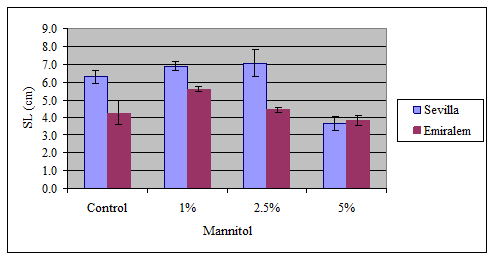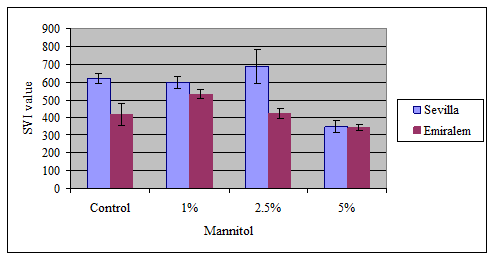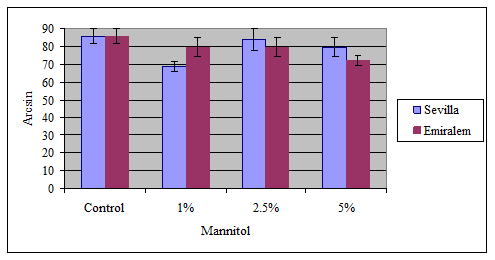eISSN: 2577-8307


Research Article Volume 3 Issue 1
1Vocational School of Higher Education in Nurdagi Gaziantep University Turkey
2Vocational School of Higher Education in Aydintepe Bayburt University Turkey
Correspondence: Alihan Cokkizgin Vocational School of Higher Education in Nurdagi Gaziantep University Turkey
Received: June 14, 2018 | Published: February 12, 2019
Citation: Cokkizgin A, Girgel U, Cokkizgin H. Mannitol (C6H14O6 ) effects on germination of broad bean ( Vicia faba L.) Seeds. Forest Res Eng Int J. 2019;3(1):20-22. DOI: 10.15406/freij.2019.03.00073
In this research, the effect of Mannitol (C6H14O6) on the germination of Vicia faba L seed was investigated. Broad bean (Vicia faba L.) genotypes, Sevilla and Emiralem seeds were treated in various levels of Mannitol (C6H14O6) (1%, 2.5% and 5%) and distilled water (2.5μs/cm) at 20°C. The experiment was arranged under completely randomized design (CRD) with three replicates in Petri dishes. In the research Seedling Length (SL), Germination Percentage (GP%), Seed Vigor Index (SVI) and Angular Transformation Value (Arcsin) was used. Accordingly, Sevilla broad bean cultivar has higher values for SL, SVI and Arcsin parameters however has a lower value for GP parameter.
Keywords: mannitol (C6H14O6), broad bean, Vicia faba, vigor, arcsin
The world produced 3.4 million tons of broad beans in 2013. The most important manufacturing countries in the world is China, Australia, France, United Kingdom and Egypt. Nearly half the world’s horse bean is produced in just two countries: China and Australia.1 Mannitol is a six-carbon sugar alcohol and wide distribution in nature.2 Also found in Fraxinus ornus.3 As a naturally occurring polyol (sugar alcohol), mannitol is widely used in the food, pharmaceutical, medical, and chemical industries.4,5 Mannitol also named as mannite or manna sugar is a white, crystalline solid and chemical formula is C6H14O6, it occurs in small quantities in most fruit and vegetables such as onions, celery, olives, beets and pumpkins.3 The aim of the research was finding out the effects of different Mannitol (C6H14O6) concentrations on broad bean (Vicia faba L.) seed germination.
Seed materials
Two broad bean cultivars Sevilla and Emiralem seeds were used under the controlled environmental conditions at Gaziantep University Vocational School of Higher Education in Nurdagi.
Seed treatments and mannitol (C6H14O6) solutions
Broad bean seeds were surface-sterilized with 5% sodium hypochlorite (NaOCl)6 and washed thoroughly with distilled water (2.5μs/cm). On the other hand, all Petri dishes were washed with tap water, after this process rinsed with distilled water and sterilized at 170°C for 4 hours in hot air sterilizer.7 Mannitol solutions were prepared 1%, 2.5%, 5% and distilled water (2.5μs/cm) as control treatment. A total of 20 seeds were put in each Petri dish on double-layer Whatman paper, and 15 ml of appropriate solution was added to each Petri dish.8,9
To eliminate fungal contamination, the germination cabinet was sprayed with Captan (N-Trichloromethylthio-4-cyclohexene-1,2-dicarboximide). All Petri dishes placed in germination cabinet at a temperature of 20°C and 50% RH for 9days.10 The Petri dishes were arranged in a Completely Randomized Design (CRD) with three replications. During the germination period, the Petri dishes were observed and germinated seeds were counted daily.
Seedling length (SL)cm
The seedling length was the total length of radicle and plumule and it was measured in centimeters with using caliper.11
Germination percentage (GP)%
Germination of seeds was counted daily according to the Association of Official Seed Analysts method.12 After 8 days of seed, the germination percentage was calculated using the formula below for each replicate of the treatment.13
Seed vigor index (SVI)
SVI was calculated according to Baki & Anderson14as follows:
Angular Transformation (Arcsin) Value. The angular transformation of final germination percentage calculated according to Erdogan15 and Olszewski et al.,16 and its formula is
Statistical analysis
By using the Statistical Analysis System Software (v.9.0), the analysis of variance results were evaluated.17 The experimental design was CRD with three replicates and means of treatment were considered significantly different at p<0.05. Mean separation was performed by Least Significant Difference (LSD) test.18
Seedling length
According to averages, statistically significant differences were found between mannitol treatments in terms of seedling length. 1% mannitol treatment has highest SL value (Table 1). In terms of genotypes, SL significantly affected by Mannitol treatments which is cv. Sevilla has higher SL value (5.98 cm) than cv. Emiralem SL value (4.54 cm). Seong et al.,19 reported that the seedling length decreased when the mannitol concentration increased (Table 1).
|
SL (cm) |
GP (%) |
SVI |
Arcsin |
||||||||
Sevilla |
E.A. |
Mean |
Sevilla |
E.A. |
Mean |
Sevilla |
E.A. |
Mean |
Sevilla |
E.A. |
Mean |
|
Control |
6.30 |
4.27 |
5.28b |
98.33 |
98.33 |
98.33a |
618.33 |
418.50 |
518.42a |
85.69 |
85.69 |
85.69a |
1% |
6.88 |
5.62 |
6.25a |
86.67 |
95.00 |
90.83b |
596.83 |
533.67 |
565.25a |
68.86 |
79.55 |
74.20b |
2.5% |
7.07 |
4.45 |
5.76ab |
96.67 |
95.00 |
95.83ab |
688.00 |
423.58 |
555.79a |
83.86 |
79.55 |
81.70ab |
5% |
3.67 |
3.83 |
3.75c |
95.00 |
90.00 |
92.50ab |
347.17 |
343.25 |
345.21b |
79.55 |
71.95 |
75.75ab |
Mean |
5.98a |
4.54b |
5.26 |
94.17 |
94.58 |
94.38 |
562.58a |
429.75b |
496.17 |
79.49 |
79.19 |
79.34 |
CV (%) |
14.579 |
5.073 |
16.464 |
10.351 |
||||||||
Table 1 Seedling Length (SL), Germination Percentage (GP), Seed Vigor Index (SVI) and Angular Transformation (Arcsin) Values of Horse Bean Cultivars with Various Concentrations of Mannitol (C6H14O6) )
Germination percentage
No significant differences between cultivars and GP of decline has been observed with mannitol applications on broad bean seeds and the highest value has obtained from control (98.33%) but 2.5% mannitol application (95.83%) has a higher value than the other mannitol applications (Figures 1– 4).

Figure 1 Differences in seedling length (cm) of broad bean cultivars under different levels of Mannitol.

Figure 2 Differences in germination percentage (%) of broad bean cultivars under different levels of Mannitol.

Figure 3 Differences in seed vigor index of broad bean cultivars under different levels of Mannitol.

Figure 4 Differences in angular transformation (Arcsin) value of broad bean cultivars under different levels of Mannitol.
Seed vigor index
Accordingly, the averages of cultivars cv. Sevilla (562.58) is significantly different from Emiralem (429.75) for SVI parameter. Also, the means of both cultivars decrease by application of 5% mannitol (345.21). On the other hand, highest SVI value observed from 1% Mannitol application (565.25).
Angular transformation (Arcsin) value
Arcsin and GP are parallel parameters and their statistic results are similar. Arcsin of decrease has been obtained from mannitol applications on broad bean seeds and highest value has obtained from control (85.69) but 2.5% mannitol application (81.70) has a higher value than the others.
The seedling length and seed vigor index are important parameters for strong emergence of plants. It’s observed that 1% mannitol (C6H14O6) application has the highest value for both parameters. Further studies are needed to enhance our understanding of how chemical compounds effects the germination of broad bean (Vicia faba L.).
None.
The author declares there are no conflicts of interest.

©2019 Cokkizgin, et al. This is an open access article distributed under the terms of the, which permits unrestricted use, distribution, and build upon your work non-commercially.